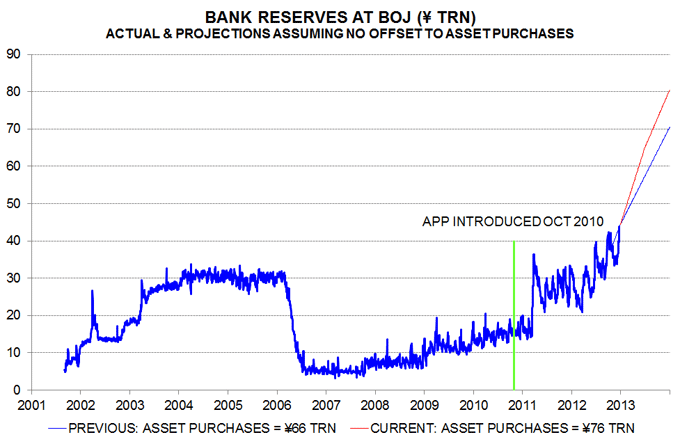The Bank of Japan (BoJ) today boosted its target for asset purchases by the end of 2013 by another ¥10 trillion to ¥76 trillion. It now plans to buy securities worth the equivalent of 7.6% of GDP in 2013 – slightly larger than the 7.3% of US GDP implied by the Fed’s announced purchases of $85 billion per month, assuming that this run-rate is sustained throughout the year.
A further substantial expansion of the programme is widely expected during the first half of 2013, although the timing will depend on the willingness of BoJ Governor Shirakawa to “co-operate” with the new government before his retirement in April.
The chart shows the implications of the new plans for bank reserves, assuming that forthcoming purchases are unsterilised and other influences net to zero*. Reserves are on course to rise to ¥80.5 trillion by the end of 2013, equivalent to 17.1% of GDP. On the same assumptions, US reserves will amount to 16.0% of GDP if QE3 is sustained at $85 billion per month.
The BoJ’s planned actions, in other words, are already on a scale suggesting a significant impact on markets and the economy. As previously discussed, however, their effectiveness would be enhanced by lengthening the maturity of securities purchases – longer-term bonds are more likely to be held outside the banking sector, in which case buying by the central bank results in a direct boost to the broad money supply in addition to a rise in bank reserves**.
*This is reasonable but uncertain. Other changes on the BoJ’s balance sheet have partly offset the reserves impact of asset purchases to date – reserves have risen by ¥28.0 trillion since October 2010 versus securities buying of ¥39.2 trillion. Another BoJ easing initiative – the “fund-provisioning measure to stimulate bank lending” – could result in additional reserves creation.
**The BoJ currently limits buying of government securities, which account for ¥68.5 trillion of the ¥76 trillion asset purchases target, to Treasury bills and JGBs with a remaining maturity of less than three years.